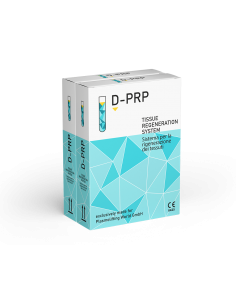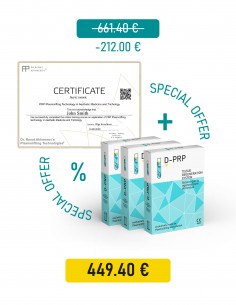Nasal PRP Plasmolifting: Solving the Problem of Dependence on Vasoconstrictor Drops in 2 Procedures
PRP powder for the treatment of chronic and medicinal rhinitis, dryness of the nasal mucosa, developed by Dr. Renat Akhmerov, the author of the Plasmolifting technique.
Platelet-rich plasma (PRP) has long been used in medicine and is one of the few approved methods in regenerative medicine. Its application for tissue healing and "growth" is legally accepted worldwide (provided medical technology is followed). The active component of PRP is platelets—blood cells that respond to tissue damage. When injured, platelets rush to the site, release fibrin, which forms a blood clot, and stimulate healing. Platelets contain numerous growth factors, including vascular endothelial growth factor (VEGF), basic fibroblast growth factor (bFGF), epidermal growth factor (EGF), sphingosine-1-phosphate (S1P), angiopoietin-1 (Ang1), platelet-derived endothelial growth factor, and others. Through a wide range of membrane receptors and soluble mediators released during platelet activation, platelets affect immune and inflammatory responses, stimulate tissue remodeling, and promote the growth of new blood vessels. This is crucial for ensuring tissues are supplied with immune cells, oxygen, and nutrients.
How Does Nasal PRP Plasmolifting Work and What is This Procedure?
Nasal Plasmolifting (PRP therapy for the nose) is a non-invasive treatment of the nasal mucosa using a dry form of platelet-rich plasma (PRP). This plasma is produced as a powder that retains all the therapeutic properties of native liquid blood plasma. The powder interacts with a broad spectrum of immune cells, helping regulate immune responses to damage, infections, and inflammation, as well as promoting regenerative tissue remodeling mechanisms. The treatment does not cause discomfort. When inhaled, the powder distributes evenly across the nasal mucosa and reaches the nasal sinuses.
Results of PRP Powder Application:
- Normalization of nasal breathing
- Elimination of dryness
- Relief from pain and discomfort in the nose
- Reduction of inflammation in the nasal mucosa and sinuses
- Recovery of the sense of smell after COVID-19
Patients begin to feel the effects of PRP powder within 10–14 days. In the overwhelming majority of cases, 2 procedures with a one-week interval are sufficient. The effect lasts from 6 months to two years. The procedure can be performed on children over 14 years old.
Who Invented PRP Powder and Was the First to Use It?
The Plasmolifting method was invented by Dr. Renat Akhmerov, who developed the technique over 20 years ago and has successfully applied and advanced it ever since. Today, Plasmolifting is actively used not only in dentistry, dermatology, and cosmetology but also in treating musculoskeletal diseases, gynecology, and urology. Research shows that PRP therapy yields positive results, for example, in studies of intra-articular injections.
In recent years, platelet-rich plasma has found new applications in weight loss, Alzheimer’s disease treatment, and the treatment of nasal mucosa, sinuses, and the upper and lower respiratory tracts. PRP powder was patented by Dr. Renat Akhmerov 5 years ago. He himself used the method: "Personally, I cured my chronic rhinitis and have been breathing normally through my nose for over 5 years. I have cured my friends and colleagues. The therapy works well for dry nose syndrome and is recommended after ENT surgeries. One of the most remarkable cases I had was the successful treatment of a patient with nasal mucosal atrophy after years of cocaine use. The mucosa recovered, and the nose started breathing again."
How Does Your Breathing Feel?
We breathe automatically and only notice the process when something is wrong. Even then, many people treat a runny nose lightly—due to the easy access to vasoconstrictor drops and the rapid effect of such "treatment," people fall into a trap. At first, everything is fine: the drops help, and the nose breathes. But over time, a person realizes that they can’t breathe freely without the precious bottle. Dependence on vasoconstrictor drops is unpleasant in itself. However, this is only the tip of the iceberg: such medications dry out the nasal mucosa and stimulate its atrophy, drying it out. The further the process progresses, the harder it becomes to breathe without the drops. Chronic inflammation develops—medication-induced rhinitis. The nose is constantly blocked, and it becomes a source of discomfort and painful sensations: itching, burning, dryness. The drops no longer work for long, and the person wakes up in the middle of the night unable to breathe. Breathing through the mouth causes dryness in the throat, leading to micro-injuries and pain, potentially developing into pharyngitis or tonsillitis. When lying down, nasal swelling increases, and the person has to sleep almost sitting or semi-sitting. Snoring (apnea) may occur, leading to the risk of stopping breathing during sleep. Against this background, chronic oxygen deprivation of the brain and other body systems develops, immunity weakens. A person finds it hard to work, perform daily tasks, quickly gets tired, and often suffers from colds, viral, and bacterial infections—flu, ARVI. A neurosis develops: if the drops are unavailable, the dependent person feels anxiety, fear, and even panic.
Why Does Dependence on Vasoconstrictor Drops Develop?
The main reason is the prolonged use of vasoconstrictor medications, which typically contain oxymetazoline or xylometazoline. These substances constrict blood vessels and reduce mucus production in the nasal mucosa. Doctors do not recommend using them for more than 5 days and no more than 4 times a day. But who goes to the doctor for a consultation about a runny nose? And who reads—and, most importantly, follows the instructions? No one counts "sprays," and people generously spray their mucosa day after day.
What Happens to the Nasal Mucosa of a Person Dependent on Vasoconstrictor Drops?
The mucosa no longer performs its protective function and doesn’t produce the protective secretion—mucus—that forms a colloidal secretory film. This film contains T- and B-lymphocytes, immunoglobulins, macrophages, neutrophils, basophils, and eosinophils. The secretory film prevents the penetration of infectious agents—bacteria and viruses—captures dust and dead cells, and the cilia of the respiratory epithelium continuously move it toward the choanae (internal nostrils) through which air enters the upper respiratory tract, and nasal secretions flow into the throat. Normally, the mucus is removed imperceptibly. However, if the mucosa is overwhelmed by too many harmful and irritating agents (dust, smog, pollen, pepper particles), it increases, and the mucus "runs" from the nose, irritating receptors and causing sneezing or coughing. The airways are cleared.
When the secretion from the nasal mucosa becomes insufficient due to the action of vasoconstrictor drops, the mucosa loses its protection and begins to dry out. The secretory film no longer covers all areas and breaks down quickly. It becomes insufficient. This film not only protects against viruses, bacteria, and dirt but also creates ideal conditions for mucosal regeneration. Normally, the nasal epithelium constantly renews itself: it is critical for these permeable, blood vessel-rich tissues to heal and regenerate quickly. Moreover, this should occur without the formation of scar tissue. Nothing should hinder normal breathing.
In a patient with addiction to drops, the mucosa cannot regenerate properly. While the body tries to repair it, constant new microtraumas caused by the drops, cracking from dryness, and chronic inflammation render all efforts futile. Over time, such a person will experience nosebleeds, and a bacterial infection may develop. Nasal passages become obstructed. The prognosis is unfavorable: the patient will live, but it would be hard to call such a life good.
Until recently, dependence on drops was treated with hormonal medications, physiotherapy, and surgery. It must be noted that not everyone is suitable for such treatment. Moreover, adherence to therapy is low: many patients discontinued physiotherapy courses or hormonal treatments. Surgical treatment also has its limitations. This new treatment method using PRP powder for the nasal mucosa has none of these drawbacks.
How Does PRP Therapy for the Nose Work?
Nasal Plasmolifting by Dr. Renat Akhmerov is a procedure that does not require injections into the nasal mucosa. An injection is only needed to take venous blood, which is then placed in PRP tubes. The blood is centrifuged, and the separated plasma is immediately turned into powder, which the patient inhales through their nose.
"Powdered plasma is a dry concentrate, produced in the presence of the patient in 30 minutes," explains Dr. Renat Akhmerov, the author of PRP powder. "That’s the beauty of this treatment—it’s dry, simple, autologous, made right before the patient’s eyes. That’s why questions about the expiration date of the drug don’t arise, and there are no concerns about rejection reactions—all the substances in the powder are maximally biocompatible; they are 'native.'"
The powder has 25 times the concentration of normal human plasma. This is a very high concentration of biologically active substances. However, the patient feels no discomfort when using the PRP powder—only a slight tickling sensation. Within a week, the mucosa begins to function as needed. It cleanses and heals itself. We perform therapy with PRP powder as a monotherapy. No combined therapy is necessary.
In the Case of Severe Mucosal Atrophy, the Procedure is Repeated Twice, and the Result is Assessed After 14 Days. If Needed, More Procedures Can Be Done.



